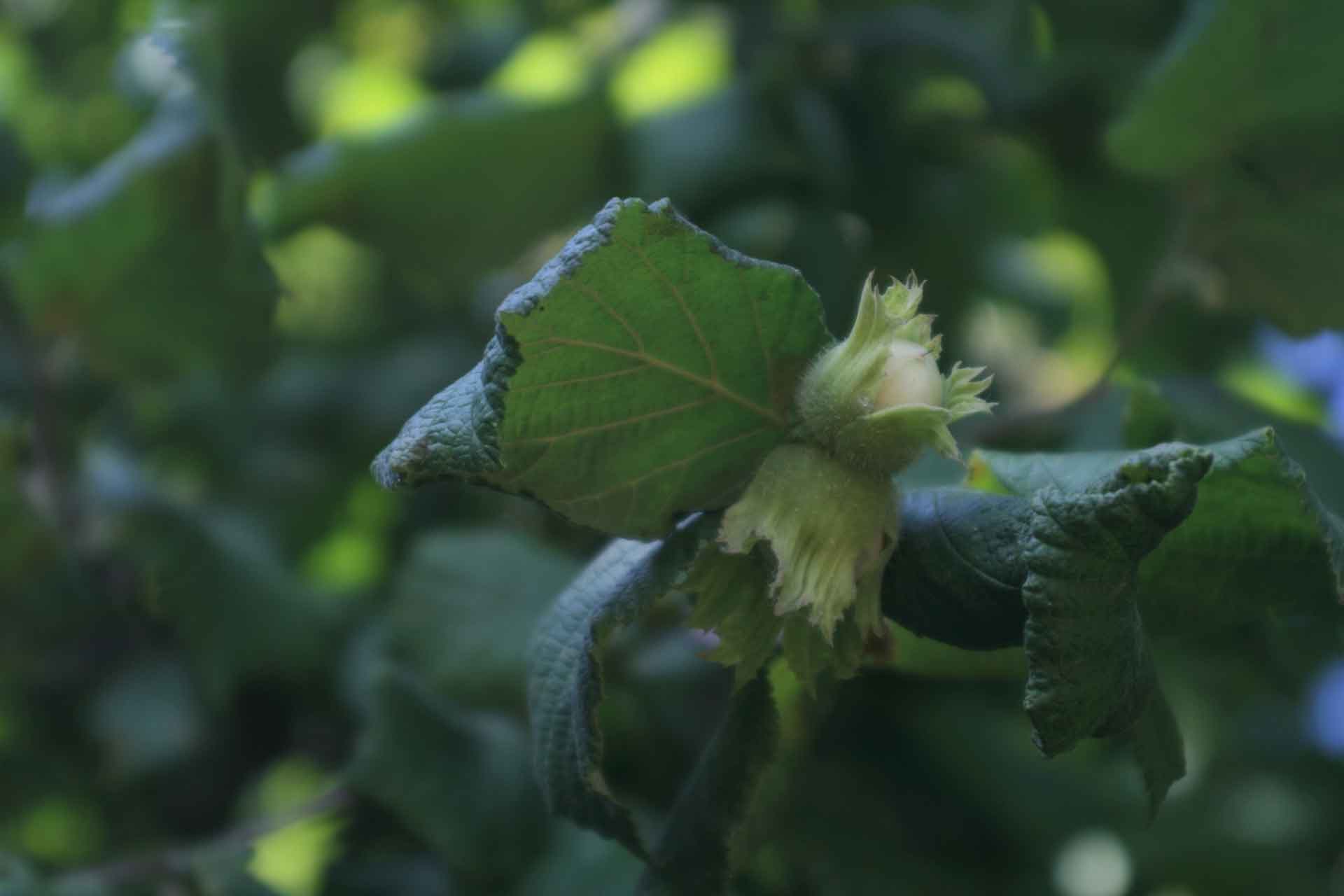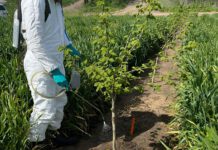Many of the 800 adults who attended the 2019 Nut Growers Society Annual Summer Tour hadn’t been on a school bus in years. But they crowded onto the long yellow busses and sat two to a seat for the hazelnut field trip. There was much joking amongst the growers about how much smaller the seats seemed since their school days. Busses departed two at a time, every 45 minutes on July 31, from the Linn County Fair and Expo Center in Albany, Oregon, heading a few miles north to Millersburg.
Christy Cooke, president of the Nut Growers Society, was the narrator aboard one of the first busses out the gate that morning. She mentioned that soil quality in the Millersburg area is a mixed bag. It includes some of the richest, well-drained soil in the state, suitable for both orchards and row crops. On the flip side, the area also has some of the most heavy, wet, unproductive soil in Oregon.
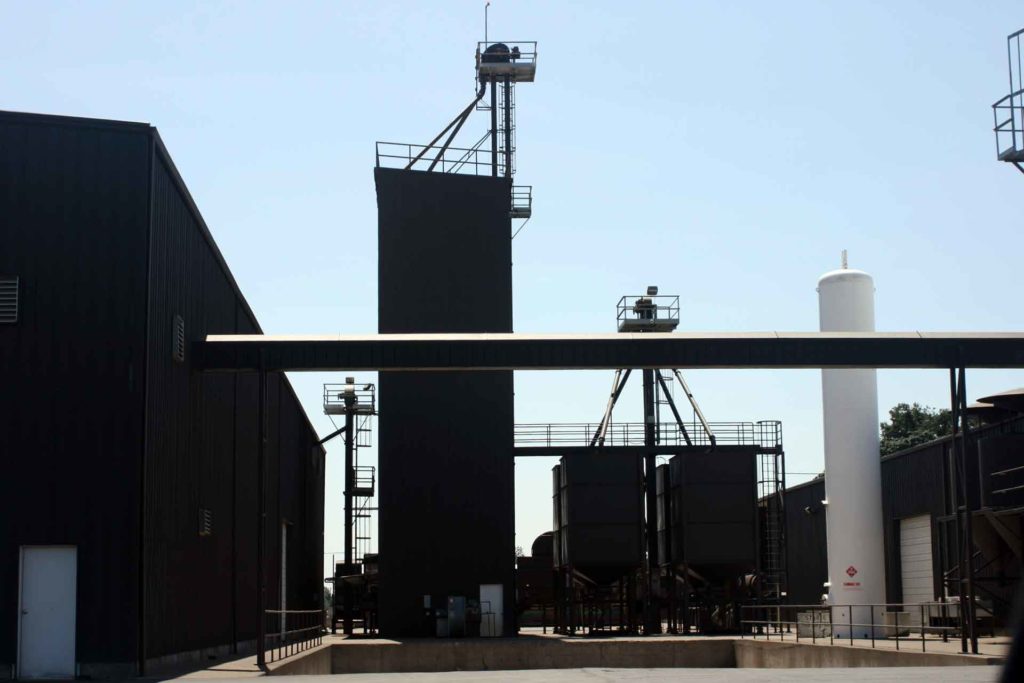
First Stop
The first stop was Paul Kuhne’s orchard, a 170-acre block of McDonald, York, Wepster and Yamhill varieties in their third leaf. Paul planted the trees double density in a 20-foot by 10-foot diamond pattern. He spaced his pollinizers every third tree in every third row. His main varieties also act as pollinizers.
At the edge of his orchard, Paul stood in the back of his truck and talked to growers through a microphone. “I bought this property six years ago. It was grass seed. Pretty good soil. Good pH,” he said. The soil is mostly Amity, Woodburn and Concord.
Paul put in 1,500-feet per acre of 4-inch drain tile. Spacing is 40-foot for Woodburn, 30-foot for Amity and 20-foot for Concord and Dayton soils. He used a GPS grid and hand augers to plant both bare root and potted trees. Some were nursery stock he grew. Paul used bamboo stakes and tree covers. Last year he removed the covers and painted the trunks, although he would recommend using tree covers for just that first year, then remove them and paint.
As for varieties, Yamhill has proved to be Paul’s favorite so far. He said it doesn’t grow as much—which he likes—and seems healthier. “We got ten inches of rain the first part of February. Some of the trees got bacterial blight, but Yamhill performed best,” he said. If a tree was hit with bacterial blight, Paul cut out the main tree and kept an unaffected sucker.
He still hasn’t made up his mind about which varieties will eventually go. “When I’m ready to remove trees, I’ll decide which to leave.”
Paul is expecting 1,000 pounds of hazelnuts an acre next year. He’ll harvest nuts after he harvests the perennial rye grass crop from between the rows. He has also tried annual grass, but it didn’t stay as well in the rows. Mice have been a problem in the orchard, so Paul has done a lot of baiting.
The orchard is watered with drip irrigation—30-inch spacing of .26 emitters. Trees receive ¼-inches of water in a four-hour cycle. Paul waters four to six hours a day during the dry months.
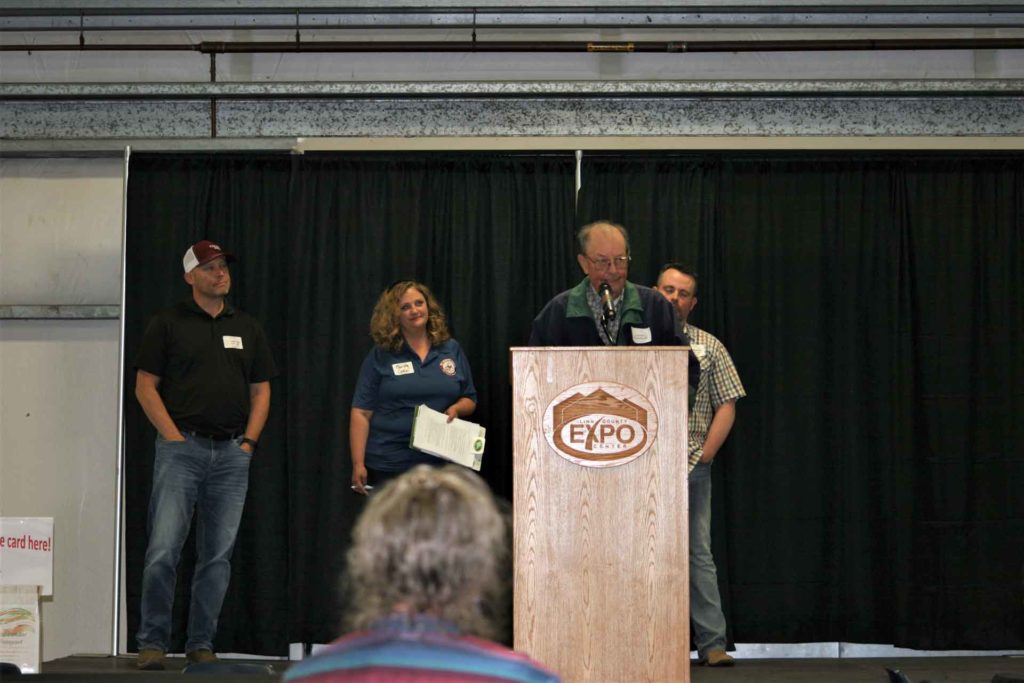
Second Stop
The second stop was a brief pause near the wash line at Cascade Foods, Inc., also in Millersburg. Attendees stayed on the bus as Christy shared information about the company:
Pat and Kim Ehli started the business in 1987, offering wash and dry services, and in-shell hazelnuts. They later expanded to shelling, roasting and dicing, and added cold storage. In October 2018, the Ehli’s sold the business to Lakeside Ag-Ventures—a group of growers from the Dever-Conner area, which is a bit north of Millersburg.
Cascade Foods has a unique dryer system with “even drying” technology, maximizing their use of energy. Each drying tower has four stages and can hold up to 40,000 pounds of nuts per stage—160,000 pounds per tower, with a total of 320,000 pounds of continuous drying capability. They were one of the first companies in the industry to begin sorting nuts by 1 mm. increments.
Stainless steel fabrication can be found throughout much of the facility. The new owners are in initial planning stages for upgrades to include more washing and drying capabilities.
The company supplies in shell, kernel, diced, roasted and raw hazelnuts worldwide. They have been a domestic-market supplier of processed hazelnuts for over 20 years.
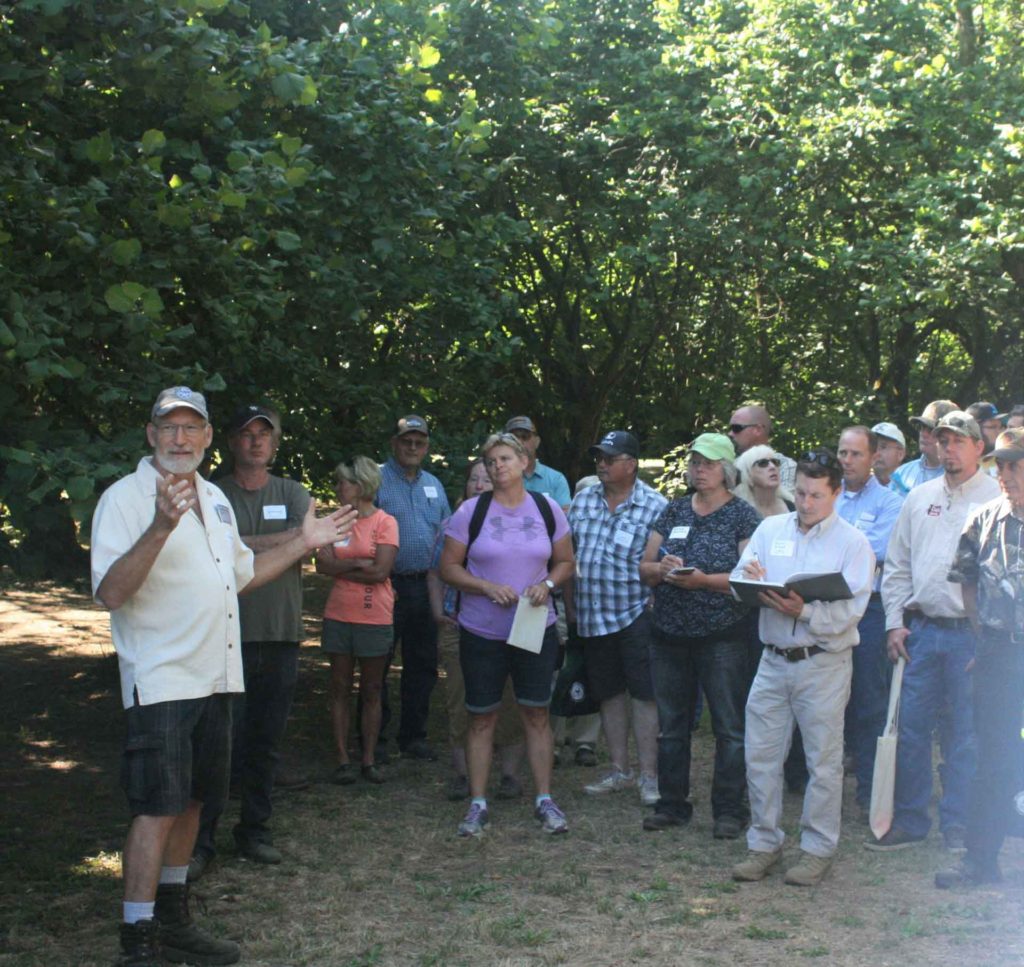
Third Stop
The third stop—or rather another pause—was at the Old Groshong Orchard, on Conser Road. N.E., off Groshong Road N.E., still in Millersburg. This orchard, planted by Bob Groshong with trees he got from Ben Dorris, is approximately 100 years old. Bob was the first grower in the industry to get a 4,000-pound yield.
For 39 years now, Wayne Chambers and his family have leased the orchard, which is planted at 22-feet by 22-feet spacing on Chahalis and Newberg soils. The antique orchard is Barcelona on their own rootstock. The original pollinizers were Daviana and DuChilly. They were planted every sixth tree in every third row. Replacement pollinizers are Ennis, Montebello, Butler, and Halls Giant.
If the orchard could talk, it would tell tales of reoccurring battles with flooding, as well as how it withstood a heavy snow fall in 1935, a heavy spring snow in 1959, the Columbus Day Storm in 1962, a silver thaw in 1967 and a severe freeze in 1972. The trunks of the trees are mostly gone. Orchard managers left suckers to grow to replace the trunks, which has kept the trees in production, even 100 years later.
On down the road, the trees are Barcelona on Turkish rootstock. A little further west and around a bend on Conser Road, a large sign labeled the trees “Halls Giant on Turkish Rootstock.” The bus slowed so growers could take a look at the old trees. Large in diameter, the trunks are gnarled and mostly hollow. Christy said when the replacement pollinizers were young, farmhands threw the pruned branches up into the trees to pollinate them. Over the decades, the taproots of the ancient trees have bored deep into the earth. Wayne Chambers believes they reach so deep they have tapped into the aquifers from the river across the road.
The last orchard on the right is a Barcelona. It’s planted on a 25-foot by 25-foot grid, because the plot of land started out as a walnut orchard planted on a 50-foot by 50-foot pattern.
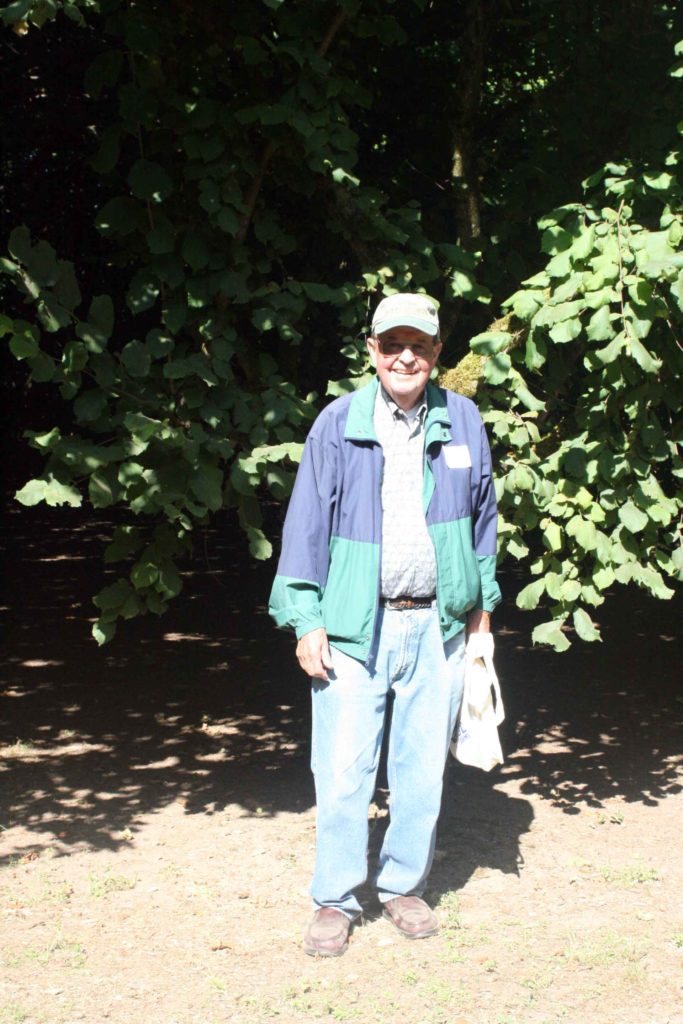
Fourth Stop
Wayne’s 125-acre Orchard was the fourth stop. Wayne planted the orchard with nine by 18-foot spacing, with the intention of removing every other tree. But Wayne is a man who loves his trees, and he wound up not thinning the double-density-planted orchard. As a result, the trees have grown taller than in the average orchard, stretching to reach sunlight. The canopy has closed. The micro climate beneath the trees is considerably cooler than outside the orchard. There is little vegetative growth on the orchard floor.
To reach the tops of the trees, Wayne uses air blasts for spraying. His advice for air blasting tall trees? “Go slow. Don’t spray on windy days.”
Before the tour, in the morning welcome speech and introductions by the tour hosts, Wayne thanked Oregon State University (OSU) for “saving our bacon.” He said, “Every time we thought, ‘this is a dandy variety,’ something was wrong, EFB (Eastern Filbert Blight) or something.” Oregon State University has bred many Eastern Filbert Blight resistant trees, including Jefferson, Yamhill, McDonald and Wepster.
Hazelnut breeder Dave Smith, and Becky McCluskey have both done extensive research in Wayne’s orchard through Oregon State University. They were on hand to lead visitors on the tour, share information and answer questions.
“The canopy is really up there,” Becky said, tipping her head back. “If you don’t have a sprayer that will reach, you might want to rethink taking out your trees.”
The orchard has many genetically-interesting trees, including a series of sons or daughters of Jefferson, as well as Jefferson’s mother. Also growing is Tonda Pacifica—a parent of McDonald and Wepster. Tonda Pacifica was licensed for sales to South America, where EFB isn’t a problem. “It was too good to throw away,” Becky said.
Thick-shelled Montebello, (the name means “beautiful mountain,” according to Becky), grow in the orchard, along with Yamhill, and Felix. The latter was planted in 1997 and ’98 as pollinizers.
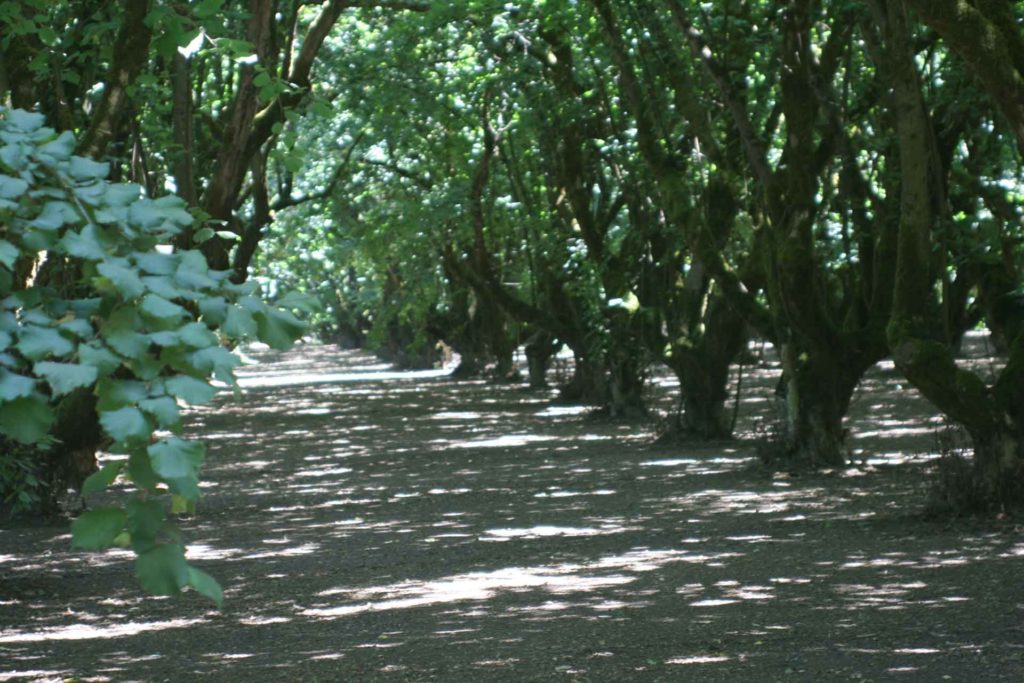
Final Stop
On the way to the final stop, headed south, on the right and across a field, Christy pointed out an orchard of Lewis (a 1997 non EFB resistant OSU variety), followed by a Clark orchard. The last stop of the tour was another of Wayne’s orchards. He planted Barcelona trees there in 1969, using 18 by 18 foot spacing. Other varieties in the orchard include Wepster, McDonald, Sacajawea and Lewis. OSU has numbered varieties intermixed among the named varieties.
At the south end of the orchard remain some of the original old Barcelona trees that Wayne planted in 1969. He planted Daviana at the same time to serve as pollinizers. The Davianas have since been replaced with younger trees. Getting pollen from the younger trees up into the older, taller trees has proved problematic. Another issue Wayne battles in the last orchard is a gravel bar. He’s tried dragging the rocks out, but it hasn’t helped significantly.
As far as hazelnut orchards go, 1969 was a good, if labor intensive year for Wayne. But six years earlier Wayne celebrated another banner year. In 1963, he graduated from OSU, got married and planted his first orchard.
About the last couple of harvest seasons, Wayne said, “We’ve had extremely good crop years for the last two years.” But about this year’s outlook, “I think they got tired,” he said of the trees.







